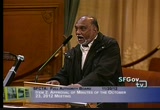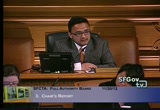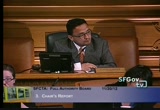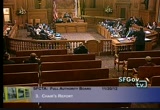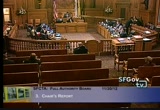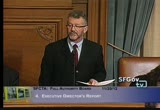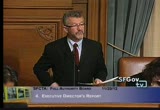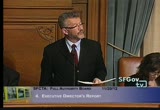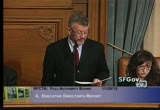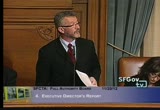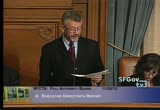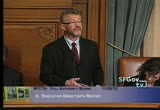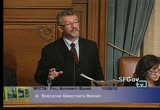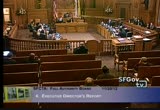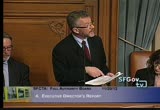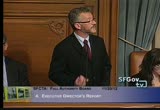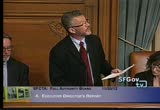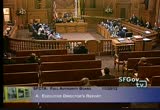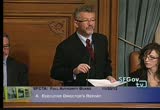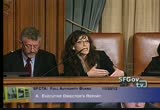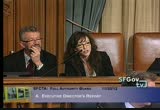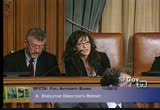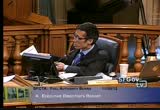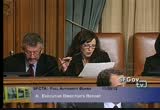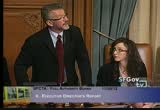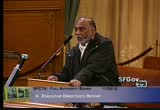tv [untitled] December 3, 2012 7:30am-8:00am PST
7:30 am
concerted effort to listen to his pleas. but i tell you it's high time that we in the minutes, when somebody says something about that thing it reflects -- it reflects [speaker not understood] that there should be some short term and long-term goals regarding connecting balboa station to visitacion valley. and then bringing that all the way to fourth and king. thank you very much. >> thank you. is there any other member of the public who would like to speak on this item? seeing none, public comment is closed. we can take our roll call on this. [roll call]
7:31 am
minutes passed. >> item passes, thank you. if you can now call item number 3. >> item number 3, chair's report, this is an information item. >> thank you very much. i have some brief remarks today. as you know, we are about to enter the holiday season and i want to begin by wishing everyone a happy thanksgiving and hopefully everyone here and those who are watching will be able to spend some time with family. i do want to thank our staff at the sf county transportation authority for all the work that they have done this year. i think that we have accomplished a lot and i look forward to having a more in-depth discussion about some of those accomplishmentses at our next meeting. as you know, we had an election on november 6 and we had some interesting developments in terms of revenue, at least, at the state level we saw some relief being brought by prop 30. we also saw a couple of
7:32 am
transportation measures that failed in alameda county and in los angeles, and i think that as we are analyzing the reasons for those results, it's important for us here in san francisco to have a better understanding of why perhaps that happened as we think about our own transportation needs going forward. of course, the most significant development at the federal level was the reelection of president obama. and i think that what that means for transportation, not only in the state of california, but nationwide, is pretty significant including, of course, what it does to high-speed rail. and the president has been a very strong supporter of that and that's something that we have been pushing for here in california and we want to make sure that we continue our efforts. but that certainly is a positive development on that -- on that front. as we move forward to the next year, one of the things that i'd like to ask my colleagues is to simply think about some of the priorities that we
7:33 am
should have as a body, not only priorities in terms of the individual projects or needs that each one of our districts has, but also collectively the priorities for the city. i know that we have seen a great deal of cooperation between the county transportation authority and the sfmta and i think that it's important for us to continue those efforts. and one of the things that i wanted to see next year is to -- and focus more on how we improve some of the coordination that is taking place among the various city agencies, especially around some of the major projects. i thought, you know, in the last few months we have seen exactly how that coordination, that cooperation has worked well. we also have seen examples of how it hasn't. and, so, to the extent that what we as a funding agency can play a role in facilitating and enhancing that cooperation i would like to see that. and that's one of the items i'd like to have at a future
7:34 am
meeting, to have a more in-depth discussion and a conversation, really, with all the different agencies that work with the county transportation authority about how we can improve that level of cooperation and corroboration. i think it will lead to greater efficiencies in how some of these projects are delivered. so, that's it unless you have any questions. i will open it up to public comment. any member of the public who would like to speak on item 3, please come forward. mr. chair, i like your comments. what i want to focus on are the youth that we have here in san francisco. with the mtc, the san francisco county transportation authority, the mta, together with the board of supervisors and especially this body, if we focus on our youth and hug them as much as we can to meet their transportation needs. * help them and one of the ways we can do
7:35 am
that is by having a lively discussion as to how our monies are spent and have a broader view. we seem to be more focused on the operations and the machines rather than the living and the human beings who are [speaker not understood]. thank you very much. >> thank you. is there any other member of the public who would like to speak on this item? seeing none, public comment is closed. madam clerk, if you can please doll item number 4? >> executive director's report, this is an information item. >> now we will curran it over to our executive director. mr. moskovich, i want to thank you and your staff as we near the end of the calendar year for all the work that has been done this calendar year. >> thank you, mr. chairman. my report was a couple of additional handouts as well. i'm only going to focus on five of the items in the report in the interest of time. the first thing i'd like to
7:36 am
comment on is that we have on the van ness vip project, bus rapid transit project, we've submitted the revised exception fact sheets to caltrans. as you know, caltrans has jurisdiction over the design on van ness avenue because it is a state route. and we are working very closely with the mta to make sure that we have a really top notch design for this bus rapid transit route in san francisco, the first fully featured vrt project to come through, probably in the north american continent of this kind. and we anticipate getting an approval from caltrans in early january. the publishing of the final eirs is now slated for february and that should allow us to bring the certification actually into this board on both the federal and the state
7:37 am
documents by march 2013. in addition to that, i want to point out that we spent the last month and a half or so negotiating with mta on a transition plan. as you may recall, the plan all along has been for the authority to clear the project environmentally and then turn it over to the mta to finalize design and get it built. and that moment has come and i'm very pleased to report that we have reached agreement. i signed the transition plan document a couple days ago and, so, we are on schedule with that and will be a further action that will take place with an updated memorandum of the agreement between the two agencies which will come to you [speaker not understood] in december and that will
7:38 am
memorialize at the policy level what we have already agreed to at the staff level. so, i'm really delighted about that and very confident that we're moving forward with the van ness vrt project in a most positive way. there are people who are interested in looking at the details of where the project is can go to www.van ness vip, all one word, dot-org. the bayview [speaker not understood] study has continued to advance as well as community outreach related to that plan. in collaboration with the department of public health and their bayview zone initiative, the next meeting -- there was a meeting of the community, working group, earlier this month. and the next one will be on december 11 at 10:00 a.m. at the bayview ymca which is located at 1601 lane street.
7:39 am
the san francisco transportation plan, which as you know is our long-range planning document for favors thaition in the city 30erctiontion -- 30-year document under development. and as you know, we had an online survey the last month and a half or so that provided essentially a budget gain for people to provide their input on how to prioritize the over $3 billion in discretionary funds that will be available over the life of the plan for transportation priorities in the city. we have tremendous -- response of over 600 people took part in the game online and provided the detailed answers. those, of course, are going to be used in the process of refining the list of projects and programs that will be
7:40 am
proposed for the next stages of the plan. also in response to agency comments, we have integrated pedestrian bicycle and travel management programs into the performance evaluation so that we have more complete picture. the results along with input received in the course of the public outreach will be used to inform [speaker not understood]. the next meeting of the advisory committee for the san francisco transportation plan is on november 28 at 6:00 p.m. at the authority's offices. 14 55 market street, second floor. the target for completion of the plan is summer of 2013. and will go entirely with the adoption of the regional transportation plan. in connection with that online to and for public input, got submitted to a national
7:41 am
competition that was organized by the transportation research board, which is the branch of the national academy of scienceses that deals with transportation nationwide. and we actually won among four national initiatives as one of the best public outreach tools in the country. so, we're going to be receiving a recognition for that at the january meeting of the transportation research board. and i want to congratulate my staff, our deputy for planning and all the people that participated in the process of putting that together, our deputy for technology services as well, elizabeth. it really is a great opportunity to bring people closer and make it real for them how we make decisions in terms of transportation priorities. and my final item is about the
7:42 am
[speaker not understood] bay area grant. we closed the project september 27 for [speaker not understood] the program over the next four years. on october 26, a month later we received 12 applications for a total of $62.6 million worth of projects. so, almost twice as much money as we have. and we set up a process for prioritizing those projects and those funds. it's a two-step process. in the first step we prioritize an initial list. we provide them with some money to do further development on the projects. then we bring them back a few months later so that we can evaluate how those project sponsors have refined the projects and sharpened their pencils to make them fit within the money that's available.
7:43 am
that first phase, that first set of priorities in draft form is on your desks in the form of a matrix with very, very small font. it's not a reading exercise. it's an attempt to make it all fit in a small amount of real estate. the first page is the actual list of projects. the second page is the priority list. this is a draft -- this is [speaker not understood] committee structure, the committee in december for discussion and hopefully a blessing and then we'll come back to the board in december for approval. and, again, that's not set. the projects are going to be funded. it simply sets the projects that are prioritized so that we can give the sponsors a little bit of help further developing the design and refining the scope of the projects and the cost so that we can make them
7:44 am
fit in the program. it's a novel way of prioritizing projects. there are more than 30 prioritization criteria that come from mtc and what the board adopted a few months ago and i'm looking forward to the results of this. i will point out that this program is a really important way to support the idea of complete streets. this is about the regional transportation funding agency and the authority putting together a set of projects that can set the pace for how we do well integrated projects and our complete streets projects that consider all the forms of transportation that can improve mobility in the city. this isn't just street resurfacing or just bicycle or just transit. this is about integrating, coming up with a [speaker not understood] set of projects. that is really all. -- i wanted to highlight. i wanted to answer questions on those items. that concludes my report.
7:45 am
i do want to echo the chair's best wishes for all of you for a wonderful thanksgiving and i look forward to your questions. thank you. >> thank you. commissioner avalos. >> thank you, chair campos. just a question on the application for one bay area grab. are we looking to have like multiple applications that are going to be above $35 million which is going to be available for obag, or are we actually going to have a packet that adds up to $35 million? i'm concerned that when we get to a bunch of applications that could be in competition with one another, and generally my district doesn't do very well in those competitions. >> let me see if i understand your question. what we have is a set of applications that exceeds the available money by about $25 million or so.
7:46 am
there's 35 million available -- 33 million available and 62 million in projects. we're not going to receive any further applications because the application process closed on october 26. so, what we have is what there is. the [speaker not understood] step is to prioritize projects that seem to fit well with the criteria. and, in fact, that's the matrix you have with you. in the second column from the left is a script and a number of projects have been prioritized to continue developing them and those four projects at the bottom that i recommended to fill out the list simply because the scores are so low. at that point the projects that are shown on the list above the line are still adding to more than the $33 million that are available. there will be further refinement of that list. hopefully not by vetting projects, but by reducing the
7:47 am
scope on the, on the projects that are prioritized. >> so, i'm not sure that, i'm not sure that this will necessarily weed out or help surface projects in a district by district basis, but the list is going to be a very strong list as far as the criteria that we're set up regionally. * >> right. and the other thing that i should emphasize is that for the projects that do double up, they will be helped in the form of [speaker not understood] funding so the sponsors can refine the project and be even more competitive. >> okay, thank you for the answer. i'm kind of confused by what's the line -- i have 12 projects
7:48 am
on the list. all the 12 projects are above the line, you're saying? or is there a line invisible to me i'm not quite aware of what it is? >> the 12 projects that are shown there are the projects that will be brought to you on -- at the [speaker not understood] in december. that list of projects will come with a prioritization. that will be a very preliminary prioritization that will have been discussed with the department and with the other sponsors. this, by the way, is not just the department, nonprofits sponsoring projects and so on. what i anticipate is because this list adds up to a lot more than the $33 million, there is going to be maybe three or four projects at the bottom of the list that are going to be
7:49 am
probably not recommended for further funding. this list is not -- this list is not prioritized today. so, what you're seeing here is the inventory [speaker not understood]. the sweep stakes is in matching this list to the scores that will be a combination of mtc and local scores so that you can have at least a closer to the $33 million that are available. >> i thought you were saying we had a list on our desk today that has a score. [speaker not understood]. >> right. >> okay, thank you. >> thank you. commissioner cohen. >> thank you very much, mr. chair. i have a question for you, director, about the list of 12 organizations -- 12 large departments and/or agencies. i see one nonprofit that is on this list. my first question is are there applications that didn't make the first initial cut? are there organizations or departments that didn't make
7:50 am
the first initial cut or is this a total composite list of everyone that applied? >> this is it. this is the list of everybody who applied. >> okay. >> $62 million worth of projects. >> great. and my other question is can you explain to me who is sitting on the evaluating committee and what is the criteria that you're using to evaluate who is going to be evaluating these applications? >> let me ask our deputy of the projects [speaker not understood] to give you the detailed answer on that. the criteria essentially set by mtc and the authority board and you approved those criteria several months ago. >> okay. you can refresh my memory in what that criteria is. >> absolutely. good morning, deputy director for policy and programming. i believe in june of this past year, the authority board approved a set of prioritization and screening criteria that will be applied
7:51 am
to the abag coffer from elks. -- projects. [speaker not understood] based on the metropolitan transportation's criteria with a few particular prioritization criteria added for emphasis, in particular, complete [speaker not understood] pedestrian safety, task force identified areas that we could ascertain how these projects would be able to meet san francisco's priorities. so, there were a few additional criteria that were added to mtcs. we have developed a scoring matrix that is based entirely on the prioritization criteria approved by the board, [speaker not understood] scores about how the projects are able to meet the criteria. we have distributed that list of scoring to the applicants so that they have been able to
7:52 am
review the preliminary scores that have been given to their projects. we are working with the sponsors right now to provide feedback if they are not in agreement on a certain scoring, but their project has been given at this time, but there is detailed instruction for how the score has been given. we're in the middle of the process. this was distributed earlier -- at the end of last week and comments will be coming back from sponsors by next thus and we'll integrate those comments into the plans and programs recommendation. >> okay. so, to confirm what i'm looking at, the 12, like i said, we have very large organizations. we've got bart, we've got dpw. i see sfmta as well as tjpa. then i see a small nonprofit group. is there some kind of weighting of the scores or is everyone on equal footing in this application process?
7:53 am
>> [speaker not understood] actually have to be an eligible applicant to apply. you have to have what's called a cooperative master agreement in place with the state department of transportation. this particular nonprofit does not have that agreement, so, their project would need to be sponsored by an agency that does have this agreement, mta, dpw, the port. >> right. >> dph. we have been working with this agency, the executive director of api and also the mta, to figure out what's the best way to move the scope of this project further either integrating it into mt's existing old program curriculum and outreach, or whether there needs to be a stand alone project. we're also in communication with dph on this issue. we're trying to figure out what's the best way to move this project forward. >> okay, good, i'm glad to hear [speaker not understood]. i'm under the impression apri has reached out to dpw to work
7:54 am
as co-sponsors on this particular project. so, my next question is in terms of the timeline, when will apri or dpw have to make a decision and approve their new project proposal to you? >> it would need to be as soon as possible. the abag program is geared towards capital projects and this is more of an operation-based project so that even aside from the sponsorship issue, there are other things that we're trying to address in the application. but we would need -- apri did need an eligible project sponsor as soon as possible. [speaker not understood] mta as well. >> thank you. >> thank you. commissioner mar. >> thanks. and i wanted to just say that i'll review the criteria. i know that a number of the
7:55 am
projects impact multiple districts. i note for one number 4, the fulton street gate enhancement probably impacts districts 5, 6 and a little bit of 1. the biggest one down at the bottom, number 11, the masonic avenue complete streets. i think it's a tiny bit of 2 and much of 5 and a little bit of 1 as well. but is that a part of the criteria, that it's going to impact the broader range of supervisorial districts than just one? i know it's based largely on need and how it fits a complete streets model, i'm guessing, but what about the range of supervisorial districts that might hit? >> one of the prioritization -- one of the primary prioritization for mtc was supported by development areas. that is the guiding principle as far as geography. >> and the pdas or the priority development areas are mostly in
7:56 am
the eastern neighborhoods, is that right? >> primarily. we can certainly provide you with a map, but yes, it is primarily in the eastern side of the city. but not only, not exclusively, though. >> and i had a question about the safe routes to schools. i know that there are two on the list. i'm wondering does dph and dpw and even the school district look at the city-wide needs and prioritize it or does it just come up -- well, why would ert [speaker not understood] be on the list and not -- betsy car michael and schools in the bayview, for example? but i'm just wondering. >> right. there are actually three safe routes to school applications, et cetera, on this list. they do stem from a combination of identification efforts. one is a city-wide identification of project needs and there are also walking
7:57 am
audits that are performed by the department of public health and also the safe routes to school members to identify specific projects to be implemented in the near future. >> and the two that i see on the list look like they're build outs and it looks like they cost [speaker not understood] for a build out. that sounds like a lot of money for a build out. i'm wondering if you could talk a little about that. >> as far as the project scope, it is a collection of different scope elements. so, it's not to say that the $500,000 cost is only build outs. but we can certainly provide more details on the scope elements. >> let me add to that, commissioner mar, it's a very good question. the $100,000 build out would be
7:58 am
a bar r bargain in this town. * based on individual location, whether the [speaker not understood] is involved, whether there is a fire hydrant in the vicinity of it and so on, the cost of relocating [speaker not understood] is tremendous. we've seen build out costs of $200,000, and even more over the years. and those are numbers that go back five and six years. so, it's unfortunate that these things cost so much because it limits the amount we can do. but it's not out of line with historic trends we've seen. >> it just sounds that i should have my staff check in with dph about the safe routes to school priorities and look to see what the school that are on that list are so that the next round of abag proposals can include more of the schools. >> that's correct. and we can also send you the current list of schools that are on the list to have walking audits. >> that would be great, thank you.
7:59 am
>> and the district elementary school. i would like to clarify. >> colleagues, unless there are any other questions or comments, why don't we open it up to public comment. mr. chair, you do know that i make it a point to come here from time to time to understand the deliberations that are going over here. now, certain women who have a lot of experience from the bayview came to me and explained to me one of the meetings that was mentioned by the director here under the auspices of the san francisco health department. now, i think the san francisco county transportation authority should have a detailed orientation on what really is
97 Views
IN COLLECTIONS
SFGTV: San Francisco Government Television Television Archive
Television Archive  Television Archive News Search Service
Television Archive News Search Service 
Uploaded by TV Archive on

 Live Music Archive
Live Music Archive Librivox Free Audio
Librivox Free Audio Metropolitan Museum
Metropolitan Museum Cleveland Museum of Art
Cleveland Museum of Art Internet Arcade
Internet Arcade Console Living Room
Console Living Room Books to Borrow
Books to Borrow Open Library
Open Library TV News
TV News Understanding 9/11
Understanding 9/11